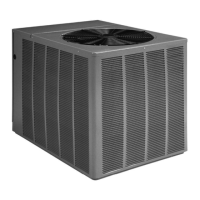LOSS OF LUBRICATION
SYMPTOMS POSSIBLE CAUSE CHECK OR REMEDIES
Compressor failures Line tubing too long Add oil to the recommended level
L
ine tubing too large Reduce pipe size to improve
oil return
Low suction pressure Low charge Check system charge
Refrigerant leaks Repair and recharge
Cold, Noisy compressor - Slugging Dilution of Oil with Refrigerant Observe piping guidelines
Noisy compressor Migration Check crankcase heater
Cold, sweating compressor Flooding Check system charge
Low Load Reduced air flow Dirty filter
D
irty coil
Wrong duct size
Restricted duct
Thermostat setting Advise customer
Short cycling of compressor Faulty pressure control Replace control
Loose wiring Check all control wires
Thermostat In supply air stream,
out of calibration,
Customer misuse
FLOODED STARTS
SYMPTOMS POSSIBLE CAUSES CHECK OR REMEDIES
Liquid in the compressor shell Faulty or missing crankcase heater Replace crankcase heater
Too much liquid in system Incorrect piping Check Piping guidelines
Overcharge Check and adjust charge
SLUGGING
SYMPTOMS POSSIBLE CAUSES CHECK OR REMEDIES
On start up Incorrect piping Review pipe size guidelines
TEV hunting when running Oversized TEV Check TEV application
FLOODING
SYMPTOMS POSSIBLE CAUSES CHECK OR REMEDIES
Poor system control Loose sensing bulb Secure the bulb and insulate
using a TEV
Bulb in wrong location Relocate bulb
Wrong size TEV Use correct replacement
Improper superheat setting Adjust, if possible;
Replace, if not
Poor system control Overcharge Check system charge
using capillary tubes
High head pressures Dirty heat pump
Restricted air flow
Recirculation of air
Evaporator air flow too low Adjust air flow to 400 CFM/Ton
47

